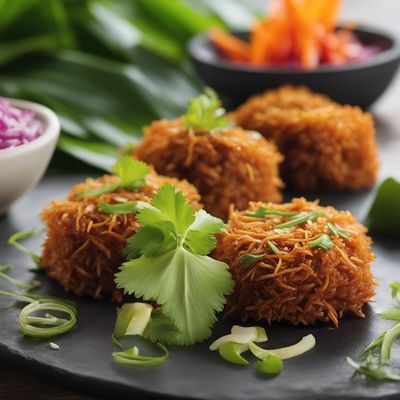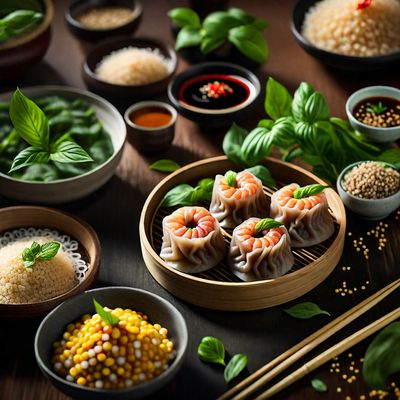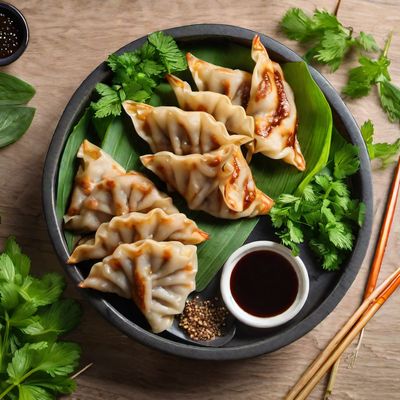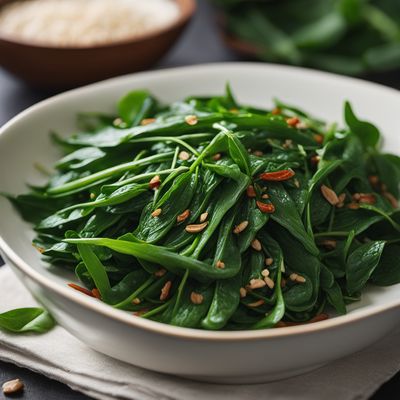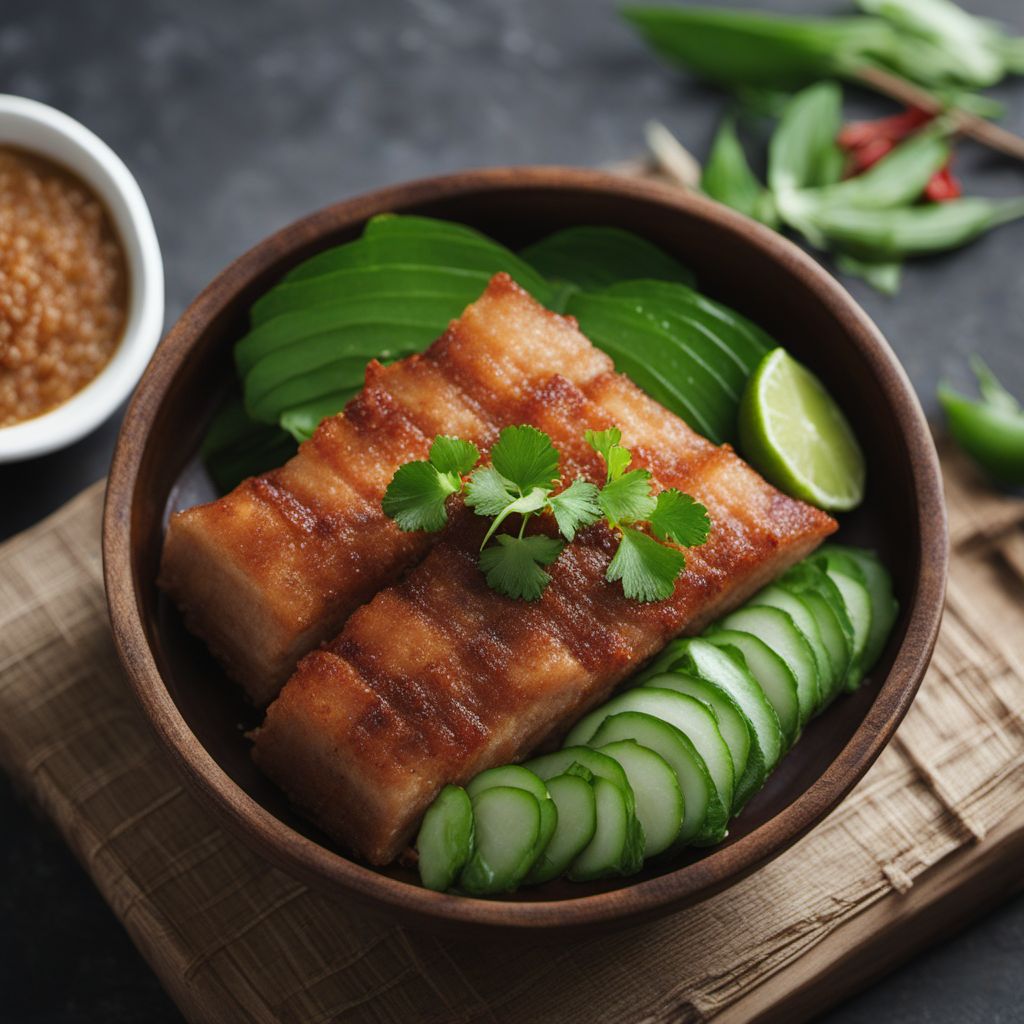
Recipe
Bánh Khoai - Vietnamese Taro Cake
Savory Delight: Vietnamese Taro Cake - A Culinary Masterpiece
4.5 out of 5
Indulge in the flavors of Vietnamese cuisine with Bánh Khoai, a traditional taro cake that is a beloved delicacy. This recipe combines the earthy sweetness of taro with aromatic spices, creating a harmonious blend of flavors.
Metadata
Preparation time
30 minutes
Cooking time
45 minutes
Total time
1 hour 15 minutes
Yields
4 servings
Preparation difficulty
Medium
Suitable for
Gluten-free, Dairy-free, Nut-free, Shellfish-free, Low sugar
Allergens
Crustaceans (shrimp), Pork
Not suitable for
Vegan, Vegetarian, Paleo, Keto, High protein
Ingredients
-
500g (1.1 lb) taro, peeled and grated 500g (1.1 lb) taro, peeled and grated
-
200g (7 oz) rice flour 200g (7 oz) rice flour
-
100g (3.5 oz) mung bean paste 100g (3.5 oz) mung bean paste
-
100g (3.5 oz) shrimp, peeled and deveined 100g (3.5 oz) shrimp, peeled and deveined
-
100g (3.5 oz) pork belly, thinly sliced 100g (3.5 oz) pork belly, thinly sliced
-
2 shallots, finely chopped 2 shallots, finely chopped
-
2 green onions, thinly sliced 2 green onions, thinly sliced
-
2 tablespoons fish sauce 2 tablespoons fish sauce
-
1 tablespoon vegetable oil 1 tablespoon vegetable oil
-
1 teaspoon sugar 1 teaspoon sugar
-
1/2 teaspoon ground black pepper 1/2 teaspoon ground black pepper
-
Dipping sauce: Dipping sauce:
-
2 tablespoons fish sauce 2 tablespoons fish sauce
-
2 tablespoons lime juice 2 tablespoons lime juice
-
1 tablespoon sugar 1 tablespoon sugar
-
1 red chili, thinly sliced 1 red chili, thinly sliced
Nutrition
- Calories (kcal / KJ): 320 kcal / 1340 KJ
- Fat: 12g, Saturated Fat: 4g
- Carbohydrates: 45g, Sugars: 4g
- Protein: 8g
- Fiber: 3g
- Salt: 2g
Preparation
-
1.In a large bowl, combine the grated taro, rice flour, mung bean paste, shallots, green onions, fish sauce, sugar, and black pepper. Mix well until all the ingredients are evenly incorporated.
-
2.Heat the vegetable oil in a pan over medium heat. Add the pork belly and shrimp, and cook until they are cooked through and slightly caramelized. Remove from heat and set aside.
-
3.Grease a round cake pan with oil. Pour half of the taro mixture into the pan and spread it evenly. Layer the cooked pork belly and shrimp on top, and then cover with the remaining taro mixture.
-
4.Steam the cake over high heat for about 45 minutes, or until the taro is tender and cooked through.
-
5.While the cake is steaming, prepare the dipping sauce by combining fish sauce, lime juice, sugar, and sliced chili in a small bowl. Stir until the sugar is dissolved.
-
6.Once the cake is cooked, remove it from the steamer and let it cool for a few minutes. Cut into slices and serve with the dipping sauce.
Treat your ingredients with care...
- Taro — Make sure to peel the taro before grating it. It is important to handle taro with gloves as it can cause skin irritation for some individuals.
- Mung bean paste — If you can't find mung bean paste, you can make your own by soaking mung beans overnight, then cooking and mashing them until smooth.
- Shrimp — Choose fresh shrimp and devein them properly before using. You can also substitute shrimp with diced chicken or tofu for a different variation.
- Pork belly — For a leaner option, you can use pork loin instead of pork belly. Make sure to slice it thinly for even cooking.
- Fish sauce — Use a high-quality fish sauce for the best flavor. Adjust the amount according to your taste preference.
Tips & Tricks
- To enhance the flavor, you can add a small amount of minced garlic and grated ginger to the taro mixture.
- If you prefer a spicier dipping sauce, add more sliced chili or a dash of chili sauce.
- Serve the Bánh Khoai warm for the best taste and texture.
- Leftover Bánh Khoai can be refrigerated and reheated in a steamer or microwave.
- Garnish the cake with additional sliced green onions or cilantro for a fresh touch.
Serving advice
Bánh Khoai is traditionally served as a main dish or as part of a larger meal. It can be enjoyed on its own or with a side of steamed rice and pickled vegetables.
Presentation advice
To present Bánh Khoai beautifully, arrange the sliced cake on a serving platter and garnish with fresh herbs such as cilantro or Thai basil. Serve the dipping sauce in a small bowl alongside the cake.
More recipes...
More Vietnamese cuisine dishes » Browse all

Chạo tôm
Shrimp Paste on Sugar Cane
Chạo tôm is a traditional Vietnamese dish made with shrimp paste and grilled on skewers. The dish is known for its smoky flavor and is often...

Canh bí đao
Pumpkin soup
Canh bí đao is a Vietnamese soup made with winter melon and ground pork. It is a light and refreshing soup that is perfect for hot summer days.

Bánh chuối
Bánh chuối is a traditional Vietnamese dessert made with bananas and sticky rice flour.
